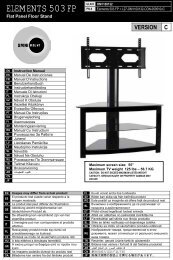AVR 255/AVR 355 Audio/VideoReceiver - Harman Kardon
AVR 255/AVR 355 Audio/VideoReceiver - Harman Kardon
AVR 255/AVR 355 Audio/VideoReceiver - Harman Kardon
Create successful ePaper yourself
Turn your PDF publications into a flip-book with our unique Google optimized e-Paper software.
System Configuration<br />
Subwoofers produce largely nondirectional<br />
sound, so they may be placed almost anywhere<br />
in a room. Actual placement should be based on<br />
room size and shape and the type of subwoofer<br />
used. One method of finding the optimal<br />
location for a subwoofer is to begin by placing it<br />
in the front of the room, about 15 cm from a<br />
wall, or near the front corner of the room.<br />
Another method is to temporarily place the<br />
subwoofer in the spot where you will normally<br />
sit, and then walk around the room until you<br />
find a spot where the subwoofer sounds best.<br />
Place the subwoofer in that spot. You should<br />
also follow the instructions of the subwoofer’s<br />
manufacturer, or you may wish to experiment<br />
with the best location for a subwoofer in your<br />
listening room.<br />
Once the speakers have been placed in the room<br />
and connected, the remaining steps are to program<br />
the system configuration memories.<br />
Although it is necessary to assign input/output<br />
settings and surround mode choices manually,<br />
we recommend that you take advantage of the<br />
power and precision of EzSet/EQ to automatically<br />
select and enter the settings for all other<br />
audio parameters. This will not only save you<br />
time; it will ensure that your room is calibrated<br />
and equalized with an accuracy not possible<br />
when these settings are made manually. You are<br />
now ready to power up the <strong>AVR</strong> <strong>255</strong>/<strong>AVR</strong> <strong>355</strong> to<br />
begin these final adjustments.<br />
First Turn On<br />
You are now ready to power up the <strong>AVR</strong> to<br />
begin these final adjustments.<br />
1. Plug the Power Cable into an unswitched<br />
AC outlet.<br />
2. Press the Main Power Switch on the rear<br />
panel so that is is in the ON position. Note<br />
that the Power Indicator 3 will turn<br />
amber, indicating that the unit is in Standby<br />
mode.<br />
3. Remove the protective plastic film from the<br />
main front-panel. If left in place, the film may<br />
affect the performance of your remote control.<br />
4. Install the four supplied AAA batteries in the<br />
remote as shown. Be certain to follow the (+)<br />
and (–) polarity indicators that are on the top<br />
of the battery compartment.<br />
5. Turn the <strong>AVR</strong> on either by pressing the<br />
System Power Control 2 on the front<br />
panel, or via the remote by pressing the <strong>AVR</strong><br />
Power ON Button A, or any of the Input<br />
Selectors C on the remote. The Power<br />
Indicator 3 will turn white to confirm that<br />
the unit is on, and the Main Information<br />
Display # will also light up.<br />
Using the On-Screen Display<br />
When making the following adjustments, you<br />
may find them easier to make via the unit’s onscreen<br />
display system. These easy-to-read<br />
displays give you a clear picture of the current<br />
status of the unit and facilitate speaker, delay,<br />
input or digital selection you are making.<br />
To view the on-screen displays, make certain you<br />
have made a connection from either the HDMI<br />
Output or the Video Monitor Out jack<br />
on the rear panel to the HDMI, component,<br />
composite or S-Video input of your TV or<br />
projector. In order to view the <strong>AVR</strong>’s displays, the<br />
correct video input must be selected on your<br />
video display.<br />
IMPORTANT NOTE: When viewing the on-screen<br />
menus using a CRT-based projector, plasma display<br />
or any direct-view CRT monitor or television, it is<br />
important that they not be left on the screen for<br />
an extended period of time.As with any video<br />
display, constant display of a static image such as<br />
these menus or video game images may cause the<br />
image to be permanently “burned into” the CRT.<br />
This type of damage is not covered by the <strong>AVR</strong><br />
warranty and may not be covered by the projector<br />
TV set’s warranty.<br />
The menu system is accessed by pressing the<br />
<strong>AVR</strong> Settings Button on the remote Y.<br />
The Main Menu will appear (see Figure 1), and if<br />
a video source is playing, it will be visible behind<br />
the transparent menu.<br />
Figure 1 – Main Menu<br />
The menu system consists of five main menus:<br />
Source Selection, Setup Source, Speaker Setup,<br />
Zone 2 and System.<br />
Use the K/L/M/N Buttons on the remote or<br />
front panel to navigate the menu system, and<br />
press the OK Button to select a menu or setting<br />
line or to enter a new setting.<br />
The current menu, setting line or setting will<br />
appear on the Lower Line of the Message<br />
Display as well as on screen.<br />
To return to the previous menu, press the<br />
Back/Exit Button. Be certain all settings are correct,<br />
as any changes you have made will be<br />
retained. When the Main Menu is on screen,<br />
pressing the Back/Exit Button will exit the<br />
menu system.<br />
System Setup<br />
The <strong>AVR</strong> <strong>255</strong>/<strong>AVR</strong> <strong>355</strong> features an advanced<br />
memory system that enables you to establish different<br />
configurations for digital input and surround<br />
mode for each input source. This flexibility<br />
enables you to custom tailor the way in which<br />
you listen to each source and have the <strong>AVR</strong><br />
memorize them. This means, for example, that<br />
you may associate different surround modes and<br />
analog or digital inputs with different sources.<br />
Once these settings are made, they will automatically<br />
be recalled whenever you select that<br />
input.<br />
However, we recommend that the first time you<br />
use the <strong>AVR</strong>, you take advantage of the<br />
simplicity of configuring the system using the<br />
EzSet/EQ process, which takes the guesswork<br />
out of speaker size and delay settings, and<br />
balances the speaker output levels to tailor the<br />
<strong>AVR</strong>’s sound presentation to your specific system<br />
and room. Before beginning the EzSet/EQ<br />
procedure, there are a few adjustments that<br />
need to be made to ensure accurate results.<br />
Source Selection<br />
For direct access to any source, press its Source<br />
Selector on the Remote Control C. Sources can<br />
also be chosen from the Source Selection menu<br />
that can be activated by pressing the <strong>AVR</strong><br />
Settings Button Y on the remote control.<br />
The <strong>AVR</strong> will switch to the audio and video<br />
inputs assigned to the source. If you specified a<br />
surround mode for the source, the <strong>AVR</strong> will<br />
switch to that mode.<br />
The source name will appear in the upper line of<br />
the front-panel display. If you retitled the source,<br />
the new title will appear. The audio input<br />
assigned to the source (analog or one of the digital<br />
audio inputs) will also appear. The surround<br />
mode will be displayed on the lower line.<br />
Any other settings you adjusted in the Setup<br />
Source menu will also be selected. You may view<br />
these settings in the Source Info menu at any<br />
time by pressing the Info Settings Button Y.<br />
20 SYSTEM CONFIGURATION















